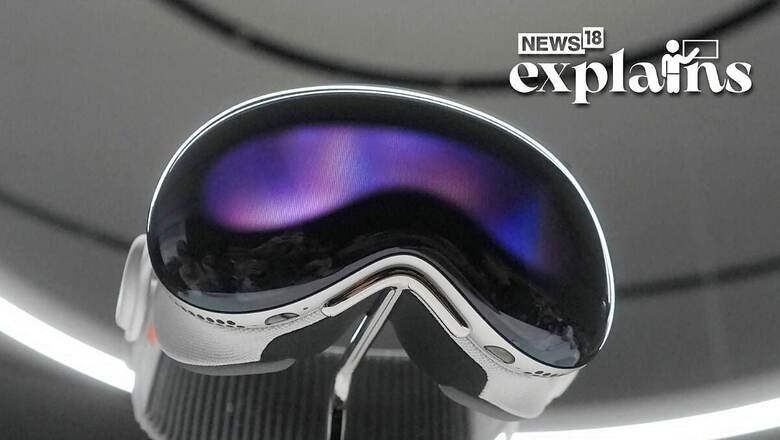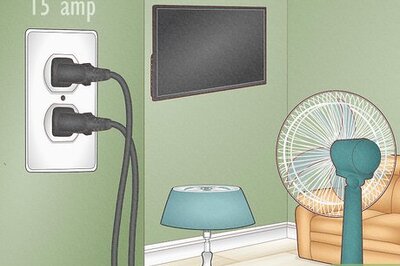
views
Apple has finally unveiled its highly anticipated headset, known as “Vision Pro,” that aims to bridge the gap between the virtual and real world. The announcement, made by CEO Tim Cook at Apple’s annual developers conference, marks a pivotal moment for the technology giant as it ventures into the realm of mixed reality.
The sleek and futuristic goggles have been the subject of speculation for years. With the ability to seamlessly switch between virtual reality (VR) and augmented reality (AR), the headset offers users a unique experience where digital imagery blends with the real environment.
Let’s understand what’s cool about this launch. News18 Explains:
Previous attempts by other companies to popularize similar devices have fallen short of capturing the public’s imagination. However, with Apple’s track record of transforming technologies into mainstream success, all eyes are on the Vision Pro to see if it can revolutionize the way we interact with digital content and redefine the future of immersive experiences.
“This marks the beginning of a journey that will bring a new dimension to powerful personal technology,” Apple CEO Tim Cook told the crowd.
Is it Available to Users Yet?
While Apple showcased the impressive capabilities of the Vision Pro headset during its event, consumers will need to be patient as the device won’t be available until early next year. Additionally, the price tag of $3,500 means that owning this cutting-edge technology comes with a substantial cost.
What Does the Device Do?
Gartner analyst Tuong Nguyen described the unveiling as a ‘teasing’ glimpse into what lies ahead, rather than a complete unveiling of the product. Apple positioned the Vision Pro as more than just a tool for virtual exploration or immersive entertainment. They portrayed it as a comprehensive multimedia package, encompassing an ultrahigh-definition TV, surround-sound system, high-end camera, and state-of-the-art gadgetry, all rolled into one sleek hardware device, as per a report by the Associated Press.
Apple emphasized its extensive product design expertise acquired over decades while developing the Vision Pro headset, which involved the filing of over 5,000 patents.
The device boasts advanced features, including 12 cameras, six microphones, and various sensors that enable users to control the headset and applications using eye movements and hand gestures. Apple claims that this immersive experience will not result in the discomfort, such as nausea and headaches, commonly associated with similar devices in the past. The company has even developed technology to generate three-dimensional digital avatars for video conferencing.
The Vision Pro aims to provide an integrated experience with minimal reliance on physical controllers, eliminating the need for clunky accessories. However, it does require either a power outlet or a portable battery connected to the headset, which may not be ideal for some users.
Will it be a Hit?
Insider Intelligence analyst Yory Wurmser acknowledged the impressive nature of Apple’s presentation, describing it as “fairly mind-blowing.” Nevertheless, analysts do not anticipate the Vision Pro to become an instant hit. That’s largely because of the hefty price, but also because most people still can’t see a compelling reason to wear something wrapped around their face for an extended period of time, the Associated Press argued in its report.
If the Vision Pro headset doesn’t become widely popular, Apple would be in a similar situation as other tech companies that have faced challenges in selling headsets or glasses with virtual reality or augmented reality features. These technologies create artificial worlds or project digital images onto real surroundings. Facebook’s Mark Zuckerberg has been promoting the concept of the “metaverse,” but it has yet to gain significant traction. While Apple’s Vision Pro is seen as a leap into spatial computing, previous attempts at virtual, augmented, and mixed reality have not generated much excitement. Google’s internet-connected glasses and Microsoft’s HoloLens headset had limited success, and Magic Leap, a startup with mixed-reality technology, had difficulties marketing its consumer headset and shifted focus to other industries like healthcare and emergency services.
How Many are Expected to Sell in the First Year?
According to Wedbush Securities analyst Dan Ives, it is estimated that Apple will only sell around 150,000 Vision Pro headsets in the first year of its release. However, sales are expected to increase to 1 million headsets in the second year. While these numbers may seem significant, they are relatively small compared to Apple’s flagship product, the iPhone, which sells over 200 million units annually. It’s important to note that the iPhone also had a slow start, with fewer than 12 million units sold in its first year on the market.
Associated Press contributed to this report















Comments
0 comment